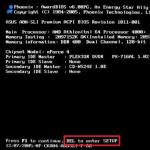Starting from version 13, a new feature is built into the browser - "Reset Firefox".
This option allows you to set all settings Firefox to the default settings, while saving, more precisely imported
All yours cookies, browsing history, saved forms history, saved passwords and bookmarks to a new profile, which becomes your default profile.
The old profile remains unchanged,
then you can use it or physically remove it ( management via profile manager see fig. 5).
Naturally, an additional option in the browser to reset settings speeds up the recovery process by creating a "clean" profile with preset passwords, bookmarks, cookies and logs which can be removed later if desired.
Some differences between the new function and the standard reset
Reset browser settings of previous versions (below 13) and current ones (from 13 and above) by starting the browser in safe mode
There is another difference - creating new profile, you name yourself created profile, and using the new option - " Reset Firefox", the browser automatically generates the title with the prefix:
default-xxxxxxxxxxxx
In the future, using the profile manager, you can rename it to any name you understand.
Function - Reset Firefox.
To reset settings Firefox, with saving personal data, you need to go to the menu bar: " reference" - "Troubleshooting Information" or type in the address bar and go to the page:
Fig 1. Browser Page - "Troubleshooting Information"
Look at the text block on this page - " Reset Firefox to its original state"and press the button" Reset Firefox"
You can safely practice with this button painlessly for yourself, because. completely new profiles will be created, and your old profile will remain unchanged.
After pressing " Reset Firefox". A window will appear to confirm the operation:
Fig 2. "Reset Firefox" window for confirmation.

If everything is in order, an information window will appear about the successful import cookies, browsing history, form history, passwords and bookmarks
Fig 3. Import Wizard.

Button " Ready"Closes the Import Wizard window.
Now, if you enter the menu - " Tools" - "Settings", then you can make sure that all parameters Firefox installed by default.
Fig 4. Web browser settings window.

To manage the created profiles, launch the profile manager.
Figure 5 shows two profiles:
- test-bl- initial profile from which personal data will be imported.
- default-1341712160015- profile generated by the browser when using the option " Reset Firefox".
Fig 5. Settings window.

Function " Reset Firefox", creates a profile and imports data from the currently active, current profile into a new one, so before performing this operation, select, if you have several profiles, the necessary one and reset the settings.
Users who do not delve into the intricacies of browsers cannot always determine the specific cause of their difficulties and therefore use mechanisms such as resetting and cleaning Firefox at their own risk. Today we will tell you about them in as much detail as possible.
Cleaning Firefox
To clarify right away: if you have some serious problems with the browser, then the likelihood that a simple cleaning will solve them is very small. First of all, it is needed in order to ensure your privacy, that is, so that the other user does not know what you have viewed, downloaded, and so on (cleaning deletes the Firefox cache, browser history, cookies).
Cleaning can also come in handy when you need to free up space on your hard drive. Since the browser profile usually lies on the system partition (even if you installed Firefox itself, for example, on partition D), then on C you will be able to free up several hundred megabytes. Or even more if you have been actively surfing the net before.
But at best, cleaning Firefox can solve problems only with individual sites, and not with the entire web browser. It is also unlikely to affect the performance of the program for the better. However, you can still try. Cleaning Mozilla Firefox is easy: open the settings and go to the "privacy and security" section.

In the window that appears, there will be a customizable list of what the browser will delete. Please note that at the top opposite the line "delete" was "everything", and not some period of time.
Among the unpleasant surprises that may await you after a complete cleaning, we note that you will have to re-log into all your accounts on various sites, as well as in mail and social networks (after all, you had to clear Firefox cookies and cache). At the same time, the browser should still save passwords and autofill data for convenience.
Your bookmarks and open tabs will not be touched, but be prepared that, returning to its original form, the page with site cells will be cleared.

Reset Firefox
Much more in solving problems with the browser from Mozilla, resetting Firefox can help. To find this feature, open the main menu and go to the "Help" section:

There you should find the item "Information for solving problems":

Clicking on it will open a new tab with a button in the upper right corner that allows you to reset Firefox. It is, however, called "clear Firefox", which can confuse an inexperienced user. In fact, this is just a browser reset and has nothing to do with the usual cleaning that we discussed above.

When you click on the button, the following warning window will appear with a short description:

Resetting will remove your extensions (removal, not disable). The settings will be returned to their original default state. And this applies not only to the main settings: it will be possible to reset all the settings in about:config. All unnecessary toolbar buttons will also disappear, returning the Firefox interface to its basic form.
If you click the Clean Firefox button from the screenshot above, you will see the Import Wizard window next:

This is a report that the program, just in case, saved all your previous “wealth” (profile) into a separate folder “Old Firefox data”, which will appear on the desktop at the same moment:

Determine what data has been deleted. With this method, you can restore deleted search engines and settings for sites and downloads. Remember that passwords, bookmarks, the list of visited sites and cookies will be restored automatically; if it doesn't, you can recover this data using the method described here.
- Restore add-ons and other settings manually. Do not restore data from backups, as this will most likely cause the problem to reoccur.
Open the Troubleshooting Information page. To do this, in the address bar of the browser, enter about: support or press ≡ - ? - Troubleshooting Information.
Open your profile data contained in a specific folder. To do this, click on the button at the top of the page. Depending on your operating system and browser version, this button will be named as follows:
- On Windows, click "Open Folder"
- On Mac OS, click Open in Folder.
- On Linux, click Open Directory.
- In Firefox 13 and earlier versions of that browser (on any operating system), click Open Folder Containing Files.
Find the data you want to recover. Before resetting settings and add-ons, user data is saved in a folder on the desktop. If there is no corresponding folder on your desktop, find the "Old Firefox Data" folder on your computer.
- You may need to show hidden files and folders on Windows.
Close Firefox. This is the only way you will be able to make changes to your profile settings.
Copy the required files to your current profile. To do this, open the "Old Firefox Data" folder and select the appropriate files (read more on how to select the correct files). Right-click on the selected files and select Copy. Open your profile folder. Right-click on an empty space in this folder and select Paste.
- On Mac OS, hold Ctrl and select files with the right mouse button.
- If a window opens on the screen, select the option "Overwrite existing files" in it.
Select the required files. It is better to copy as few files as possible to the new profile in order to reduce the likelihood of a recurrence of the problem. The following is a list of files that can be copied.
- The search engines are in the search.json file.
- Website settings (saving cookies, launching pop-ups, etc.) are located in the permissions.sqlite file.
- Download settings (that is, a list of programs responsible for opening certain downloaded files) are located in the mimeTypes.rdf file.
- The data below will be restored automatically. But if the browser reset process fails, restore this data manually.
- Bookmarks and browsing history are stored in the places.sqlite file.
- Passwords are stored in key3.db files and logins.json.
- The data for autocomplete forms is stored in the formhistory.sqlite file.
If you encounter problems with the Mozilla Firefox browser, the easiest and most affordable way to solve it is to clear the browser. This article will discuss how to perform a comprehensive cleaning of the Mozilla Firefox web browser.
If you needed to clean the Mazila browser to solve problems, for example, if performance has dropped significantly, it is important to perform it in a comprehensive manner, i.e. the matter should concern both the downloaded information, and installed add-ons and themes, and settings and other components of the web browser.
Step 1: Using Mozilla Firefox's cleanup feature
To perform cleaning in Mozilla Firefox, a special tool is provided, the task of which is to remove the following browser elements:
1. saved settings;
2. Installed extensions;
3. download log;
4. Site settings.
To use this method, click on the web browser menu button and click on the question mark icon.

Another menu will appear here, in which you need to open the item .

In the upper right corner of the displayed page, click on the button "Clear Firefox" .

A window will appear on the screen in which you need to confirm your intention to clear Firefox.

Stage 2: clearing accumulated information
Now the stage has come for deleting the information that Mozilla Firefox accumulates over time - this is the cache, cookies and browsing history.
Click the web browser menu button and open the section "Magazine" .

An additional menu will appear in the same area of the window, in which you need to select the item "Delete History" .

In the window that opens, near the item "Delete" set the parameter "Everything" , and then check all options. Complete the removal by clicking the button "Delete Now" .

Stage 3: deleting bookmarks
Click in the upper right corner of the web browser on the bookmark icon and in the window that appears "Show all bookmarks" .

The bookmark management window will appear on the screen. Folders with bookmarks (both standard and custom) are located in the left area, and the contents of a particular folder will be displayed in the right area. Delete all user folders as well as the contents of the standard folders.

Stage 4: Removing passwords
Using the save passwords feature, you do not need to re-enter your login and password every time you go to a web resource.
To delete the passwords saved in the browser, click on the menu button of the web browser and go to the section "Settings" .

In the left area of the window, go to the tab "Protection" , and on the right click on the button "Saved Logins" .

"Delete everything" .

Complete the password removal procedure by confirming your intention to permanently delete this information.

Stage 5: cleaning up the dictionary
Mozilla Firefox has a built-in dictionary that allows you to underline detected errors when typing in the browser.
However, if you don't agree with the Firefox dictionary, you can add a particular word to the dictionary, thereby forming a custom dictionary.
To reset saved words in Mozilla Firefox, click on the browser menu button and open the question mark icon. In the window that appears, click the button "Problem Solving Information" .

In the window that opens, click on the button "Show Folder" .

Close your browser completely, then return to your profile folder and locate the persdict.dat file. Open this file with any text editor, such as the standard WordPad.
All words saved in Mozilla Firefox will be displayed on a separate line. Delete all words and then save the changes made to the file. Close the profile folder and start Firefox.
And finally
Of course, the Firefox cleaning method described above is not the fastest. The fastest way to do this is to create a new profile or reinstall Firefox on your computer.
To create a new Firefox profile and delete the old one, close Mozilla Firefox completely and then open the window "Run" key combination Win+R .
In the window that opens, you will need to enter the following command and press the Enter key:
firefox.exe -P

The Firefox profiles window will appear on the screen. Before deleting the old profile(s), we need to create a new one. To do this, click on the button "Create" .

In the window for creating a new profile, if necessary, change the original name of the profile to your own, so that if you create several profiles, it will be easier for you to navigate. A little lower you can change the location of the profile folder, but if this is not necessary, then it is better to leave this item as it is.

When a new profile is created, you can start deleting the extra ones. To do this, click on the unwanted profile once with the left mouse button to select it, and then click on the button "Delete" .

In the next window, click the button "Delete Files" , if you want all the accumulated information stored in the profile folder to be deleted along with the profile from Firefox.

When you have only the profile you want, select it with one click and select "Launch Firefox" .

Resetting Mozilla Firefox settings eliminates errors that have occurred in the browser. There are two ways to perform a factory reset: by clearing Firefox using the special button on the support page, or by deleting the file that stores the settings.
Browser cleaning
The easiest way to reset the Mozilla browser to its default settings is to use the reset button on the support page. Cleaning removes settings, extensions, and themes; bookmarks, saved passwords, cookies, open tabs, auto-fill information for web forms on different sites will remain intact.
Try restarting your browser in safe mode with all add-ons disabled. If errors persist in safe mode, then go back to the support page and restore the settings that were set in Mozilla Firefox by default by clicking the "Clear" button. In the window that appears, confirm your intention by clicking "Clear Firefox".
After the reset, the "Old Data" directory will appear on the desktop, in which you will find the profile files.
If necessary, you can restore them by dropping them back into the web browser directory.
Deleting a settings file
If you have no complaints about the work of the extensions, and you do not want to lose the installed themes, then use another method to reset the settings, which is to delete the configuration file.

To restore the default settings, locate and delete the prefs.js file in the user's directory. You can do without deleting: just rename the file, adding the word "old" to its extension - prefs.jsOLD. So you save its backup copy, which will make it possible, if necessary, to restore the settings lost after the reset. 




